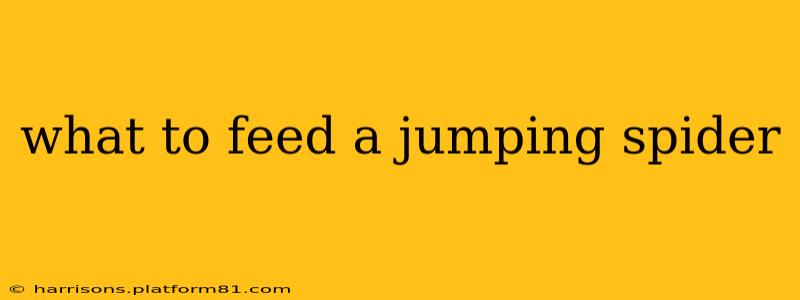Jumping spiders, with their captivating eyes and acrobatic hunting style, are popular pets among arachnid enthusiasts. Providing them with a proper diet is crucial for their health and longevity. This guide will explore what to feed your jumping spider, addressing common questions and concerns.
What do jumping spiders eat in the wild?
In their natural habitat, jumping spiders are primarily insectivores. Their diet consists largely of various insects, including flies, crickets, grasshoppers, moths, and other small invertebrates. The size of their prey will generally be relative to the spider's size; a larger spider will consume larger insects. They are ambush predators, using their exceptional eyesight and jumping abilities to capture unsuspecting prey.
What can I feed my pet jumping spider?
Feeding your pet jumping spider requires careful consideration. Avoid anything too large, as this can stress or injure your spider. Here's a breakdown of suitable food sources:
Suitable Foods:
- Fruit Flies (Drosophila): These are an excellent staple food, particularly for smaller spiderlings. They are readily available at pet stores and are easy to culture at home.
- Small Crickets: These are a good source of protein, but ensure they are appropriately sized for your spider to avoid injury. Avoid crickets that are larger than the spider's body.
- Mealworms: While a decent source of nutrition, mealworms should be fed sparingly as they have a higher chitin content, which can be harder to digest.
- House Flies: These are a great option, and catching them can be a fun, eco-friendly alternative. However, be aware of potential pesticide exposure.
Foods to Avoid:
- Large Insects: These can injure or overwhelm your spider.
- Insects from the wild: These may carry pesticides or parasites harmful to your spider. It's best to stick to captive-bred insects.
- Anything other than insects: Jumping spiders are insectivores; providing them with other food sources won't be beneficial.
How often should I feed my jumping spider?
The feeding frequency depends on the age and size of your spider. Spiderlings generally need to be fed daily or every other day. Adult spiders may only need to be fed every 2-3 days, or even less frequently if they have consumed a large prey item. Observe your spider; if they seem less active or their abdomen appears less plump, they may be hungry.
How do I feed my jumping spider?
Simply place the live insect in the enclosure near your spider. The spider will usually hunt and capture the prey independently. Do not handle the insect or spider directly unless absolutely necessary.
What if my jumping spider refuses to eat?
There could be several reasons for this. Your spider may be molting, full from a recent meal, or experiencing stress due to environmental factors. Ensure the enclosure is properly maintained, the temperature is appropriate, and there's sufficient humidity. Try offering a different type of insect. If the refusal to eat persists for a prolonged period, consult a veterinarian specializing in arachnids.
Can I feed my jumping spider dead insects?
While some sources suggest this, it's generally discouraged. Jumping spiders are active hunters that thrive on the stimulation of hunting live prey. Providing dead insects may not provide the necessary nutrients and can discourage hunting instincts.
What are the signs of a healthy jumping spider?
A healthy jumping spider will be active, have a plump abdomen, and readily hunt and consume appropriate-sized prey. Their abdomen should not be shrunken or shriveled. Observe your spider regularly to detect any changes in behavior or appearance that might indicate illness or a dietary issue.
This information should provide a comprehensive understanding of the dietary needs of your jumping spider. Remember, responsible pet ownership involves providing a suitable habitat and nutrition. Enjoy observing these fascinating creatures!
